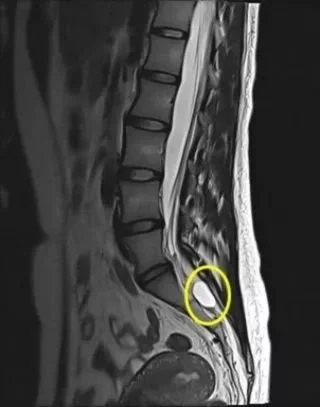SPINAL CYSTS
Spinal cysts are a relatively uncommon cause of back pain that often develop as a result of degeneration. The cysts are benign, which means that they’re not, in and of themselves, harmful or malignant (unlike a tumor). Often, they can sit unnoticed for years without any signs of pain or discomfort.
However, if they grow large enough, they can have similar symptoms to spinal stenosis and place pressure on the sensitive nerve roots exiting the spine.
WHAT IS A SPINAL CYST?
A spinal cyst is simply a synovial cyst that forms on the tendons or joints in the spine, often as the result of natural degeneration. It is a benign, fluid-filled sac that can vary in size and often go unnoticed unless they are pressing against a nerve or affecting joint movement.
Recent advances in imaging have made the diagnosis of spinal cysts more common than in previous years, but they’re still a relatively rare cause of back pain.
The exact cause of spinal cysts is unknown, but research is beginning to find that there might be a connection between natural degeneration and their formation. This would explain why they’re almost exclusively found in patients aged 50 and older and rarely found in patients younger than 45.
Synovial fluid is a gel-like substance that helps lubricate the facet joints in the sine and allows them to operate smoothly and effectively. If our bodies were a car, synovial fluid would be oil.
However, as we grow older, our joints begin to naturally wear down. In response to this, our body’s may begin to produce more synovial fluid in order to make sure that joint operation continues to be smooth and pain-free. If too much fluid begins to fill up in the synovial sac, one of the seven parts that make up a joint, it can cause a cyst.
Other systemic conditions, like rheumatoid arthritis, can also be associated with the formation of spinal cysts, though it is more rare.
WHAT ARE THE SYMPTOMS OF A SPINAL CYSTS?
A spinal cyst that is causing back pain often shares characteristics similar to spinal stenosis because it almost always involves the pinching of a nerve. Symptoms typically include:
Backache
Radicular pain (pain that results from a pinched nerve) on a particular side of your body
Pain or weakness in your arms or legs
Numbness or tingling
Pain that is noticeably worsened by leaning in a certain direction or by sitting or standing.
Exact symptoms can vary depending on the size and the location of the spinal cysts. It’s also important to note that spinal cysts are benign which means that they aren’t inherently harmful to the body. This being the case, many cysts can go completely unnoticed for years or for an entire lifetime with no consequences.
If a spinal cyst is identified in an imaging scan and isn’t causing any noticeable symptoms, your doctor might recommend simply leaving it in order to avoid any unnecessary treatment on the spine.
ARE SPINAL CYSTS DANGEROUS?
Spinal cysts are known as a benign, non cancerous lumps, which means that they are, inherently, not harmful to your body. However, the symptoms they cause can dangerous depending on their size and location. Research is beginning to suggest that they might cause instability in the spine and also permanent nerve damage if left unattended.1
If you have a symptomatic cysts, you should talk to your spine surgeon to discuss treatment options.
HOW DO YOU TREAT A SPINAL CYST?
Many cysts heal on their own, which means that conservative treatments like rest and anti-inflammatory painkillers can often be enough to get rid of them. However, in some cases, routine drainage of the sac may be necessary to reduce symptoms.
Though relatively uncommon, some cysts can refill and continue to cause problems in the spine. If this occurs there are several minimally invasive surgical options that allow a neurosurgeon to enter the spine, remove the cyst and ensure that it doesn’t reoccur.
Any patient with asymptomatic spinal cyst should contact their spine surgeon to discuss their options for permanent relief.
References
1. Spinal Cysts. (n.d.). Retrieved March 7, 2019, from https://www.hopkinsmedicine.or...
RELATED ARTICLES
NEUROSURGEON VS. ORTHOPEDIC SURGEON FOR SPINE SURGERY [2023 GUIDE]
In this article, we’ll explore the similarities and, more importantly, the differences between orthopedic surgeons and neurosurgeons and will help shed some clarity on the unique characteristics of each of these distinct medical professions.




